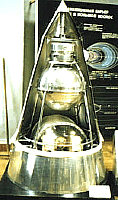
Sputnik 2
NSSDCA/COSPAR ID: 1957-002A
Description
Sputnik 2 was the second spacecraft launched into Earth orbit and was the first such biological spacecraft. It was a 4 meter high cone-shaped capsule with a base diameter of 2 meters. It contained several compartments for radio transmitters, a telemetry system, a programming unit, a regeneration and temperature control system for the cabin, and scientific instruments. A separate sealed cabin contained the experimental dog Laika. Engineering and biological data were transmitted using the Tral_D telemetry system, which would transmit data to Earth for 15 minutes of each orbit. Two spectrophotometers were on board for measuring solar radiation (ultraviolet and x-ray emissions) and cosmic rays. A television camera was mounted in the passenger compartment to observe Laika. The camera could transmit 100-line video frames at 10 frames/second.
Mission Profile
Sputnik 2 was launched on a Sapwood SS-6 8K71PS launch vehicle (essentially a modified R-7 ICBM similar to that used for Sputnik 1) to a 212 x 1660 km orbit with a period of 103.7 minutes. After reaching orbit the nose cone was jettisoned successfully but the Blok A core did not separate as planned. This inhibited the operation of the thermal control system. Additionally some of the thermal insulation tore loose so the interior temperatures reached 40 C. It is believed Laika survived for only about two days instead of the planned ten because of the heat. The orbit of Sputnik 2 decayed and it reentered Earth's atmosphere on 14 April 1958 after 162 days in orbit.
Laika
The first being to orbit the Earth was a female part-Samoyed terrier originally named Kudryavka (Little Curly) but later renamed Laika (Barker). She weighed about 6 kg. The pressurized cabin on Sputnik 2 allowed enough room for her to lie down or stand and was padded. An air regeneration system provided oxygen; food and water were dispensed in a gelatinized form. Laika was fitted with a harness, a bag to collect waste, and electrodes to monitor vital signs. The early telemetry indicated Laika was agitated but eating her food. There was no capability of returning a payload safely to Earth at this time, so it was planned that Laika would run out of oxygen after about 10 days of orbiting the Earth. Because of the thermal problems she probably only survived a day or two. The mission provided scientists with the first data on the behavior of a living organism orbiting in the space environment.
Spacecraft image courtesy of Alexander Chernov - all rights reserved.
Alternate Names
- 00003
- 1957 Beta 1
- Sputnik2
Facts in Brief
Launch Date: 1957-11-03
Launch Vehicle: Modified SS-6 (Sapwood)
Launch Site: Tyuratam (Baikonur Cosmodrome), U.S.S.R
Mass: 508.3 kg
Funding Agency
- Unknown (U.S.S.R)
Disciplines
- Life Science
- Solar Physics
Additional Information
Questions and comments about this spacecraft can be directed to: Dr. David R. Williams
Personnel
| Name | Role | Original Affiliation |
|---|
Selected References
- Merson, R. H., and D. G. King-Hele, Use of artificial satellites to explore the earth's gravitational field - Results from Sputnik 2 (1957 Beta), Nature, 182, 640-641, doi:10.1038/182640a0, Sept. 1958.
- Shelton, W., Soviet space exploration - the first decade, Arthur Barker Ltd., Unnumbered, London, England, 1969.
- Govorchin, G. G., The soviets in space - an historical survey, Spaceflight, 7, 74-82, May 1965.
- Chernov, V. N., and V. I. Yakovlev, Scientific research during the flight of an animal in an artificial earth satellite, Artif. Earth Satell., No. 1, 80-94, 1958.
- Harvey, B., The new Russian space programme from competition to collaboration, John Wiley and Sons, Chichester, England, 1996.
![[Laika]](http://nssdc.gsfc.nasa.gov/planetary/thumbnail/laika.gif)
Laika The image at the top of the page is a model on display at the Polytechnical Museum in Russia.
Image courtesy of Alexander Chernov and the Virtual Space Museum
Korolev's Triple Play: Sputniks 1, 2, and 3 - NASA History Office
Sputnik 1 Information

